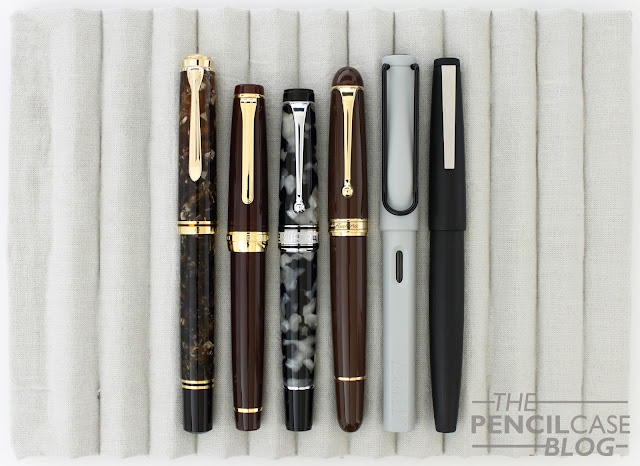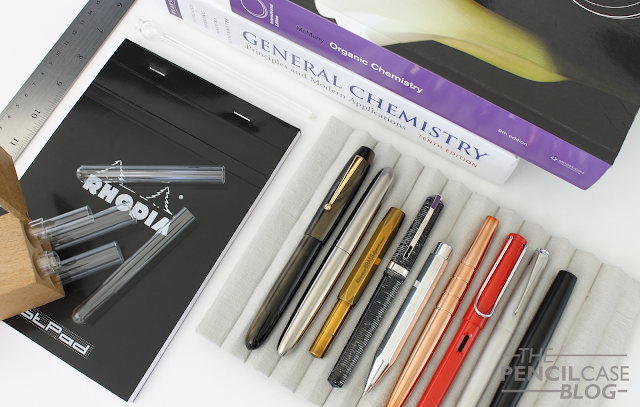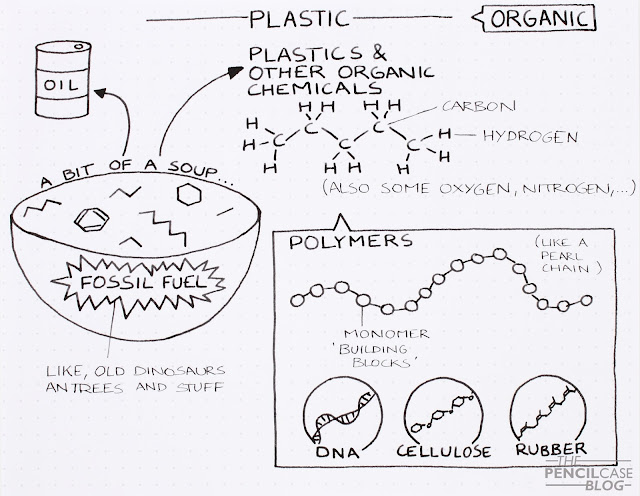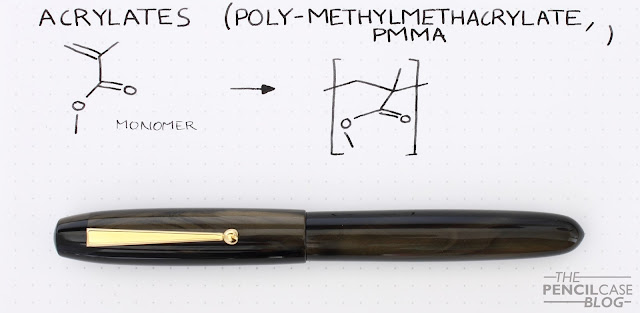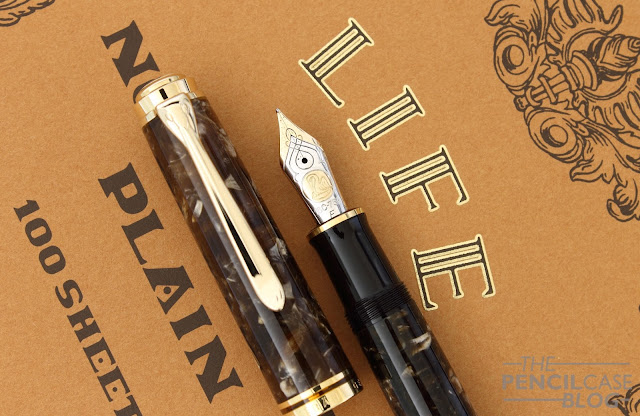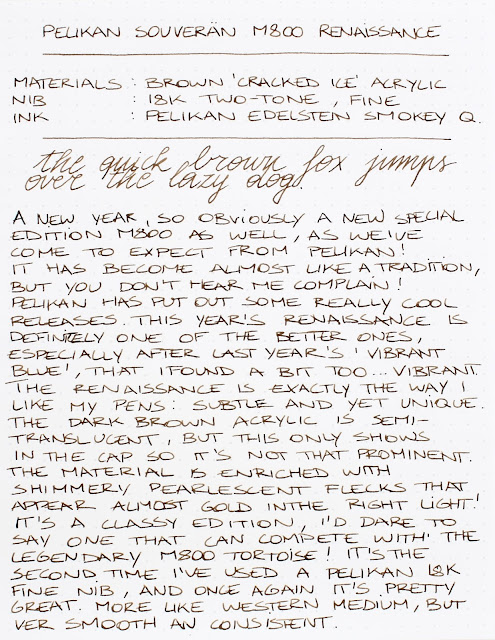 Huge anticipation preceded the new Aurora Ottantotto Anniversario limited edition, and with reason, as it was announced to come with a new flexible 14k nib. Who doesn't want some flex action these days?!
Huge anticipation preceded the new Aurora Ottantotto Anniversario limited edition, and with reason, as it was announced to come with a new flexible 14k nib. Who doesn't want some flex action these days?!
But of course, anticipation means nothing when the product doesn't deliver. So the hype partially dissapeared when the first reviews hit, in which the flexible nib was written off as, well... not so flexible. Of course, the mixed reviews only made me want to try it out more (maybe my scientific background makes me a critical thinker, maybe I'm just stubborn... probably the latter.). So I caved when Dennis from La Couronne Du Comte showed me the brown version that was released last month.
But before we talk about whether or not the nib lives up to the expectations, let's just look at the pen itself, which is basically a regular Aurora Ottantotto. All eight versions of the Anniversario have one thing in common: they are all fairly simple variations on the regular Ottantotto model. Each version is made from a different color solid acrylic, or silver/gold (plated I suppose) metal. But neither of them has an exotic material, or special finish, something Aurora is usually known for. Each Anniversario is, in essence, a regular Ottantotto in a different color, nothing more than that.
But then of course that's what you pay for. The Anniversario's are priced similarly to the regular 88's, given that the flexible nib commands a 100-150$ premium over the normal nibs (which is in line with what they will cost in the future, when they will become readily availaible on more models). I would've expected something more exotic for an anniversary limited edition, but in the end Aurora really just wanted to focus on the new nibs, not the pen around it. So that's what they did, and the result is a good looking but maybe rather plain pen.
And that's basically the first reason why the Anniversario hasn't received the attention it deserves. It's a plain pen, but it retails for more than most other Auroras, some with much more intricate and fascinating materials. The Nebulosa, for example, was released around the same time as the Anniversario pens, and it kind of overshadowed them in popularity. Frankly, I can't blame anyone for being more exited about the new Aurora Nebulosa, which shows off a beautiful and intricate purple acrylic.
Whilst it may be rather plain, it's definitely not an ugly pen, far from it really. The Ottantotto, or 88, is a classy looking model. It's subtle all the way around, with minimal engraving on the center band, and a gently curved clip with a ball end. It won't turn heads, but then again a subdued design doesn't mean an ugly design.
The brown version has been my favourite from the moment I saw the lineup of colors that would be released, for the simple reason that I think the subtle brown color matches the overall subtlety of the pen. The choice of solid acrylic colors may have been a strange choice for an anniversary pen, but I think they pulled it off and made a classy looking pen.
The Aurora Ottantotto is actually not too different from the Optima I reviewed a while ago (read here). It's basically the same pen, but with rounded top and bottom instead of the flattop design of the Optima. The center band is also different, but that's as far as the differences go. Because the Optima is basically an 88 with the top and bottom snipped off, there is a noticeable difference in size.
The difference in length, added by the rounded finials, is actually quite significant. The 88 measures 13.7 cm closed (5.4"), and 13.1 cm open (5.16"), which is almost a centimeter longer than the Optima (The Optima actually being a rather small pen). Other than the difference in length, both pens actually have a similar diameter (perhaps even identical) of around 1.4 cm (0.55") at the widest point. The section is long and wide (avg. 1.1 cm/ 0.43"), and has a pleasant tapering shape which flares out near the nib. It's a fully acrylic pen, so the total weight of the pen is limited to around 21 grams without ink.
The section is identical to the one on the Optima, which I already found quite excellent. The added length of the 88 however, makes it even more comfortable in the hand. Everything combined, the 88 is an extremely comfortable pen to write with. I've never felt the need to post the cap, but it's actually quite comfortable and balanced (the cap sits rather deep on the pen body) with the cap posted.
Let's take a look at the nib... Where do I start? Designwise, It's a simple but aesthetically pleasing nib that fits the design language of the rest of the pen. The imprint is based on a vintage design of earlier Aurora pens. I've read somewhere that imprints on flexible nibs are kept simple to reduce stress in the material, as repeated flexing can cause cracks in the nib.
As for how it performs, it's a perfectly fine Fine 14k nib (see what I did there?). It may be advertised as a flexible nib, but that doesn't mean it's not perfectly usable for everyday writing. Aurora nibs have a tendency to be slightly less polished, so you can expect a little more feedback but a lot more consistency. The ebonite feed provides a steady, slightly wet flow (I would assume it's tuned slightly wetter for optimal flex, although it seems to perform in line with the regular Aurora nibs I tried).
The reason why this nib is actually very capable for everyday writing is because it's rather stiff (which may sound a little odd, given that it's a flexible nib). You shouldn't expect an incredibly soft, springy nib like on vintage flex, or even modern titanium or soft gold nibs. It's a snappy nib, very responsive, but it requires some pressure to flex.
I'm not an expert on flex writing, but I did get some decent results out of it. The line variation is decent, but I'd call it a good semi-flex nib, calling it full flex is maybe slightly exaggerated. You'll be dissapointed if you're expecting wet noodle vintage flex like you see on Instagram (Thanks Azizah!), but you can still get very decent line variation from it nevertheles.
In my simple, not very accurate, test I could get line variation equivalent of EF to BB. Comparing to some other (semi-) flexible nibs I had on hand, the Aurora nib is definitely on the finer side, and I found it comparable in performance and flexibility to an EF titanium bock nib (although the titanium nibs feel softer and less responsive). Flex writing from something like the Wahl-Eversharp may look more impressive, but the fine nib is super wet and the line width appears much wider to begin with, so the actual variation is not necessarily better.
I've noticed a couple of people that had problems with the feed not being able to keep up with flexing, resulting in a lot of railroading. I've had it happen too, but I have a strong suspicion that it's mainly due to the choice of ink. Out of three different inks I tried (Aurora Black, Robert Oster Lemongrass, and Sailor Souten), only the Robert Oster ink (presumably the least lubricated and driest of all three) caused railroading issues. With the other two inks I could actually push it quite far without issues, even with fast writing.
There are a lot of pros and contras to this nib, but in the end I actually quite like it. It's perhaps a bit stiff, but because of that it's also perfectly usable for normal writing without having to keep a featherlight touch.
The Aurora Ottantotto is actually not too different from the Optima I reviewed a while ago (read here). It's basically the same pen, but with rounded top and bottom instead of the flattop design of the Optima. The center band is also different, but that's as far as the differences go. Because the Optima is basically an 88 with the top and bottom snipped off, there is a noticeable difference in size.
The difference in length, added by the rounded finials, is actually quite significant. The 88 measures 13.7 cm closed (5.4"), and 13.1 cm open (5.16"), which is almost a centimeter longer than the Optima (The Optima actually being a rather small pen). Other than the difference in length, both pens actually have a similar diameter (perhaps even identical) of around 1.4 cm (0.55") at the widest point. The section is long and wide (avg. 1.1 cm/ 0.43"), and has a pleasant tapering shape which flares out near the nib. It's a fully acrylic pen, so the total weight of the pen is limited to around 21 grams without ink.
Let's take a look at the nib... Where do I start? Designwise, It's a simple but aesthetically pleasing nib that fits the design language of the rest of the pen. The imprint is based on a vintage design of earlier Aurora pens. I've read somewhere that imprints on flexible nibs are kept simple to reduce stress in the material, as repeated flexing can cause cracks in the nib.
As for how it performs, it's a perfectly fine Fine 14k nib (see what I did there?). It may be advertised as a flexible nib, but that doesn't mean it's not perfectly usable for everyday writing. Aurora nibs have a tendency to be slightly less polished, so you can expect a little more feedback but a lot more consistency. The ebonite feed provides a steady, slightly wet flow (I would assume it's tuned slightly wetter for optimal flex, although it seems to perform in line with the regular Aurora nibs I tried).
The reason why this nib is actually very capable for everyday writing is because it's rather stiff (which may sound a little odd, given that it's a flexible nib). You shouldn't expect an incredibly soft, springy nib like on vintage flex, or even modern titanium or soft gold nibs. It's a snappy nib, very responsive, but it requires some pressure to flex.
I'm not an expert on flex writing, but I did get some decent results out of it. The line variation is decent, but I'd call it a good semi-flex nib, calling it full flex is maybe slightly exaggerated. You'll be dissapointed if you're expecting wet noodle vintage flex like you see on Instagram (Thanks Azizah!), but you can still get very decent line variation from it nevertheles.
In the end I think Aurora did a great job on the complete package. I'm glad I own one, but I personally wouldn't buy it just for the nib. As I mentioned earlier, all Anniversario pens retail for 620 EUR / 650 USD. If you're just looking for a flexible nib, that's too steep. But as a complete package, the 150$ premium over the regular Ottantotto is actually quite fair.
Note: La Couronne Du Comte is a sponsor of this blog. I received a discount on the purchase of this product. I was in no way influenced in the making of this review, the opinions shared in this review are completely my own! This post does not contain affilate links.





